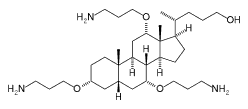Ceragenin
Ceragenins, or cationic steroid antimicrobials (CSAs), are synthetically-produced, small-molecule chemical compounds consisting of a sterol backbone with amino acids and other chemical groups attached to them. These compounds have a net positive charge that is electrostatically attracted to the negative-charged cell membranes of certain viruses, fungi and bacteria. CSAs have a high binding affinity for such membranes (including Lipid A[1]) and are able to rapidly disrupt the target membranes leading to rapid cell death. While CSAs have a mechanism of action that is also seen in antimicrobial peptides, which form part of the body's innate immune system, they avoid many of the difficulties associated with their use as medicines.[2]

Ceragenins were invented by Dr. Paul B. Savage of Brigham Young University's Department of Chemistry and Biochemistry. In data previously presented by Dr. Savage and other researchers, CSAs have been shown to have broad spectrum antibacterial activity.[3] Dr. Derya Unutmaz, Associate Professor of Microbiology and Immunology at the Vanderbilt University School of Medicine, tested several CSAs in his laboratory for their ability to kill HIV directly. According to Unutmaz, "We have some preliminary but very exciting results. But we would like to formally show this before making any claims that would cause unwanted hype."[4]
On February 6, 2006, researchers (including Dr. Paul B. Savage) announced that a Ceragenin compound, CSA-54, appears to inactivate HIV. This conclusion seems to still be awaiting peer review.[5]
References
- ↑ Ding B., Yin N., Liu Y., Cardenas-Garcia J., Evanson R., Orsak T., Fan M., Turin G., and Savage P.B.: Origins of Cell Selectivity of Cationic Steroid Antibiotics J. Am. Chem. Soc., 126(42), 13642 -13648, 2004.
- ↑ "Vanderbilt University, Brigham Young University, and Ceragenix Pharmaceuticals Report Novel Drug Compound Kills Multiple HIV Strains; Synthetic Small Molecule Acts Through Unique Strain-Independent Virucidal Mechanism". Ceragenix Pharmaceuticals. 2006-02-06. Archived from the original on 2006-05-23. Retrieved 2006-03-24.
- ↑ Savage PB, Li C, Taotafa U, Ding B, Guan Q (2002-11-19). "Antibacterial properties of cationic steroid antibiotics". FEMS microbiology letters. Retrieved 2006-03-24.
- ↑ "Chemical 'blocks HIV infection'". BBC News Online. 2006-02-09. Retrieved 2006-03-24.
- ↑ Mims, Bob (2006-03-01). "Has BYU prof found AIDS cure?". The Salt Lake Tribune. Retrieved 2006-03-24.